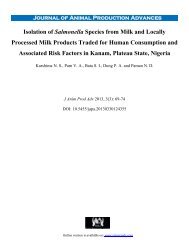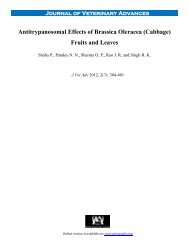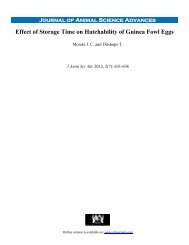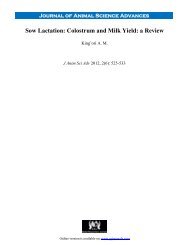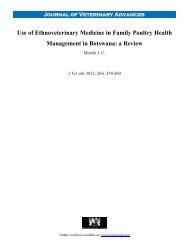You also want an ePaper? Increase the reach of your titles
YUMPU automatically turns print PDFs into web optimized ePapers that Google loves.
Journal of Animal Production Advances<br />
Egg Quality Deffects: Types, Causes and Occurrence: a<br />
Review<br />
King’ori A. M.<br />
J Anim Prod Adv 2012, 2(8): 350-357<br />
Online version is available on: www.grjournals.com
ISSN: 2251-7677<br />
KING’ORI<br />
Egg Quality Deffects: Types, Causes and<br />
Occurrence: a Review<br />
A Review<br />
King’ori A. M.<br />
Egerton University, Department of Animal Sciences. P.O. Box 536-20115, Egerton, Kenya.<br />
Abstract<br />
Poultry egg quality defects are broadly classified as external or internal. About 10% of the total eggs<br />
produced are downgraded due to external defects while 1% is due to internal defects. External defects include<br />
shell quality, cleanliness, shape, texture and soundness. Egg quality defects lower the grade, consumer appeal,<br />
storage/shelf life, hatchability, increase egg breakage and cost of packaging. Internal quality defects are in the<br />
yolk and albumen. They occur in the form of blood and meat spots, double yolks, mottled and discoloured<br />
yolks, rotten eggs, watery whites, discoloured whites and round worms in eggs. About 5-7% of eggs produced<br />
do not reach the consumer; 2-3% of the damage is due to problems during laying and 3-4% during the process<br />
after laying. No single factor is usually responsible for egg quality deffects. Factors related to egg quality<br />
defects include nutrition, health, flock management, environmental conditions and breeding. It is therefore<br />
important for the egg value chain players to understand the various types of egg defects and their causes. This<br />
will enable them device ways and means to minimize them, hence improve egg quality.<br />
Keywords: Poultry eggs, quality, shell, yolk, albumen.<br />
Corresponding author: Egerton University, Department of Animal Sciences. P.O. Box 536-20115, Egerton, Kenya.<br />
Received on: 25 Jul 2012<br />
Revised on: 06 Aug 2012<br />
Accepted on: 15 Aug 2012<br />
Online Published on: 31 Aug 2012<br />
350 J. Anim. Prod. Adv., 2012, 2(8):350-357
EGG QUALITY DEFFECTS: TYPES, CAUSES AND OCCURRENCE …<br />
Introduction<br />
Egg quality is a general term that relates to<br />
various external and internal standards that are<br />
imposed on the eggs (Koelkebeck, 2003). Some of<br />
these standards are based on subjective measures of<br />
egg quality and some are based on a more<br />
quantitative measure of egg quality. Egg quality has<br />
an influence on egg acceptance or rejection by the<br />
consumer. Egg quality defects are deviations in<br />
external and internal standards of the egg that affect<br />
the quality. Exterior quality includes egg weight,<br />
egg shape, colour, shell thickness, shell weight,<br />
shell density, texture, egg surface area, and<br />
cleanliness (USDA, 2000; Hussain, 2011). The eggs<br />
should be uniform in colour, size and shape. The<br />
shell of each egg should be smooth, clean and free<br />
of cracks. Egg weight, shape and colour are external<br />
characteristics that influence grading, price,<br />
consumer preference and hatchability (King’ori,<br />
2011; 2012). Poor eggshell quality has been of<br />
major economic concern to commercial egg<br />
producers (Washburn, 1982; Roland, 1988).<br />
Information from egg grading facilities indicates<br />
that 10% of eggs are downgraded due to egg shell<br />
quality deffects. Internal quality refers to egg white<br />
(albumen) cleanliness and viscosity, size of the air<br />
cell, yolk shape and yolk strength and involves<br />
functional, aesthetic and microbiological properties<br />
of the egg yolk and albumen. The proportions of<br />
components for fresh egg are 32% yolk, 58%<br />
albumen and 10% shell (Encyclopedia Britannica,<br />
2012). Egg albumen is the clear liquid contained<br />
within an egg. Its primary purpose is to protect the<br />
egg yolk and provide additional nutrition for the<br />
growth of the embryo. It is rich in proteins and<br />
contains almost no fat, unlike the egg yolk, which<br />
has a high fat value. The egg yolk is the yellow<br />
spherical part of an egg that is surrounded by the<br />
albumen. It is the part of the egg which feeds the<br />
developing embryo. The poultry egg is of a high<br />
nutritional value to man that is mainly attributed to<br />
egg albumen and egg yolk which are the edible<br />
components. They supply all essential amino acids<br />
for humans, and provide several vitamins and<br />
minerals, including retinol (vitamin A), riboflavin<br />
(vitamin B 2 ), folic acid (vitamin B9), vitamin B6,<br />
vitamin B12, choline, iron, calcium, phosphorous<br />
351 J. Anim. Prod. Adv., 2012, 2(8):350-357<br />
and potassium. The egg has chemicals and<br />
components (Froning, 1998) that have multiple uses<br />
in biotechnology, chemical, food, pharmaceutical<br />
and art (painting and photography) industries (Egg<br />
Tempera painting, 2011; Germadios et al, 1996;<br />
Messier, 1991).<br />
In the production of poultry eggs, the aim is to<br />
produce eggs with a high hatchability, consumer<br />
preference, and of the best grade that fetch the<br />
highest price (King’ori, 2011, 2012). However,<br />
there are certain defects that affect negatively the<br />
external and internal quality of the egg causing<br />
losses to the producer, retailer and consumer. It is<br />
therefore important to understand the external and<br />
internal egg defects, their causes and economic<br />
importance. Understanding the various egg quality<br />
deffects and their causes will assist in designing and<br />
implementing measures to minimize their<br />
occurrence, hence reducing losses in the egg value<br />
chain. This paper reviews the egg quality defects,<br />
their causes, possible solutions and economic<br />
importance.<br />
Types of Egg Deffects<br />
External defects<br />
Exterior measurements (i.e. measurements<br />
made without breaking or piercing the shell) have<br />
traditionally been done by visual inspection of the<br />
outer surface of an intact egg, to search for cracks,<br />
and by candling. However, a system with a high<br />
precision using a laser scan to detect cracks,<br />
pinholes, and thin regions in the shell has been<br />
developed - U.S. Pat. No. 5,615,777 (Or-Yehuda,<br />
2007). External egg quality deffects include shell<br />
quality, cleanliness, shape, texture and soundness<br />
(Jacqueline et al, 2011).<br />
Shell quality<br />
To the human eye, the shell of the egg appears<br />
to be a homogeneous structure with uniform<br />
composition throughout. When observed under high<br />
magnification, the structure is extraordinarily<br />
complex. It has at least six significantly different<br />
layers beginning with two shell membranes between<br />
the albumen and the interior surface of the shell.<br />
These layers are followed by three regions of<br />
calcified materials, and completed with a thin<br />
organic material on the outer surface called the
KING’ORI<br />
cuticle (Bell, 2007).Within the different layers are<br />
crystalline interfaces, hundreds of hidden fault lines,<br />
and thousands of pores (tiny tunnels which travel<br />
from outer to inner surfaces of the shell). The small<br />
amount of organic matter mostly consists of matrix<br />
proteins (mixture of proteins and polysaccharides<br />
rich in sulphated molecules) and shell pigment. The<br />
matrix proteins are critically important in<br />
determining the egg shell structure and serves as<br />
foundation for the deposition of calcium carbonate<br />
during the mineralization process (Burley et al.,<br />
1989; Lavelin et al., 2000; Gupta, 2008). Without<br />
the matrix proteins, the crystal structure would be<br />
too brittle to keep its form.<br />
The chicken eggshell is 95-97% calcium<br />
carbonate crystals, 0.3% phosphorous and<br />
magnesium and traces of sodium, potassium, zinc,<br />
manganese, iron and copper and organic matter<br />
(Arias et al., 2001; Nys et al., 2004; Hunton, 2005;<br />
Neospark, 2012)). The structure and composition of<br />
the avian eggshell serves to protect the egg against<br />
damage and microbial contamination, prevention of<br />
desiccation, regulation of gas and water exchange<br />
for the growing embryo, and provides calcium for<br />
embryogenesis. The eggshell should be as strong as<br />
possible to maximize the number of eggs reaching<br />
the consumer. No single factor is usually<br />
responsible for egg shell quality. Factors related to<br />
eggshell quality include nutrition (the nutrient<br />
balance and intake levels of the ration), health (the<br />
flock’s general health and previous health history),<br />
flock management and its age, environmental<br />
conditions and breeding (the strain and breed of the<br />
flock) along with other factors (Bell, 2007;<br />
Neospark, 2012). About 5-7% of eggs produced do<br />
not reach the consumer; 2-3% of the damage is due<br />
to problems during laying and 3-4% during the<br />
process after laying.<br />
Types of Shell Deffects<br />
They include shell thickness, gross cracks,<br />
hairline cracks, star cracks, misshapen egg, pimples,<br />
sand paper, pinhole, leatherly and glossy eggs. The<br />
complexity of structure of the shell gives rise to<br />
differences in breakage in eggs. The crack severity,<br />
shape and length are results of variations in the<br />
structure with fractures occurring at the points of<br />
least resistance (Bell, 2007). Shell deffects account<br />
for 0.5-5-6% of total production. Nutrition plays a<br />
key role in maintaining egg quality. The hens<br />
should be offered a balanced ration. Vitamin D,<br />
calcium, phosphorous, manganese, copper and zinc<br />
play a major role in maintaining the integrity and<br />
shell quality. Excess or reduced concentration of<br />
phosphorous, chlorine, or mycotoxin contamination<br />
affects the availability of calcium and vitamin D.<br />
Calcium and phosphorus balance is critical for<br />
proper egg production and eggshell quality. Layer<br />
ration should be formulated with correct amount of<br />
calcium and phosphorus (usually 3.5 - 4.0%<br />
calcium, 0.35-0.40% phosphorus).Numerous factors<br />
affect the functional quality of the egg shell mostly<br />
prior to egg laying. The thickness of the shell is<br />
determined by the amount of time it spends in the<br />
shell gland (uterus) and the rate of calcium<br />
deposition during shell formation. If the egg spends<br />
a short period in the shell gland, the thickness will<br />
be less (Neospark, 2012). Also, the time of the day<br />
when the egg is laid determines the thickness of the<br />
shell. In general, the earlier in the day or light<br />
portion of the photoperiod, the thicker the shell will<br />
be. Intestinal absorption of calcium in the diet is<br />
about 40% when the shell gland is inactive, but<br />
reaches 72% when active. This time closely<br />
coincides with late afternoon or the dark hours for<br />
the layer. Having higher calcium levels in the gut<br />
during this time is important to ensure calcium is<br />
being taken from the diet and not bone.<br />
Shell quality affect consumer appeal,<br />
packaging, egg breakage, storage/shelf life, and<br />
hatchability (Rogue et al., 1994; King’ori, 2011).<br />
An egg shell that is smooth is desirable because<br />
rough shelled eggs break more easily. Large sized<br />
eggs usually break more easily than small ones<br />
because the hen is genetically capable of placing<br />
only a finite amount of calcium in the shell<br />
(Neospark, 2012). Reduction in shell quality lowers<br />
egg shelf life, hatchability and increases breakage.<br />
Shell thickness and porosity regulate the exchange<br />
of carbon dioxide and oxygen between the<br />
developing embryo and the air during incubation<br />
(Rogue, 1994). Shell thickness has significant effect<br />
on moisture loss during storage and incubation<br />
(Bennett, 1992). Thin shelled eggs loose more<br />
moisture than do thick –shelled eggs, causing<br />
352 J. Anim. Prod. Adv., 2012, 2(8):350-357
EGG QUALITY DEFFECTS: TYPES, CAUSES AND OCCURRENCE …<br />
difficulty during hatching (Rogue et al, 1994) and<br />
deterioration on quality for table eggs.<br />
Viral infections (Infectious bronchitis (IB),<br />
Newcastle disease (ND) and Egg drop syndrome<br />
(EDS)) can lead to loss of shell colour, as well as<br />
egg deformities and a reduction in egg numbers<br />
(Thear, 2005). IB virus causes soft/rough shelled<br />
eggs, discolouration and wrinkling of the shell. Egg<br />
drop syndrome (EDS) is a viral infection that results<br />
in a reduced number of eggs, as well as an increased<br />
number of pale-shelled eggs. EDS virus affects only<br />
the shell gland but with ND or IB, every portion of<br />
the reproductive tract can be affected. The<br />
roughness of the egg shell increases with age and<br />
when serious may result in some downgrading.<br />
Molting corrects the problem to a degree, but when<br />
flocks are kept in lay beyond 30–40 weeks, many<br />
eggs become very rough and consumers may find<br />
this displeasing. The hen loses her ability to<br />
mobilize calcium from the bone, and is less able to<br />
produce the needed calcium carbonate. The<br />
absorption and mobilization of calcium decreases to<br />
less than 50% of normal after 40 weeks of age. The<br />
practice of "forced" or "induced" moulting has been<br />
shown to improve shell quality in all ageing flock.<br />
Following the moult, egg specific gravity, shell<br />
weight, shell thickness and percentage shell are<br />
either the same as they were prior to the moult, or<br />
had improved, for all strains. Induced moulting<br />
improves egg shell breaking strength in all strains.<br />
Use of certain chemotherapeutic agents can affect<br />
the intensity of pigmentation. Sulfa drugs affect the<br />
eggshell quality. The presence of the coccidiostat<br />
Nicarbazin in the feed can produce paler shells<br />
(Thear, 2005).<br />
Poor housing, high ambient temperature, rough<br />
handling of the eggs will affect the eggshell quality.<br />
Since large eggs are more prone to cracks, the egg<br />
size must be managed through proper nutritional<br />
and lighting management. Eggs from hens in the<br />
3L: 1D (3 days light: 1 day dark) regimen had a<br />
significantly greater shell breaking strength than<br />
eggs from hens in the 16L: 8D (16 hours light: 8<br />
hours dark) regimen. The hens on the 3L: 1D<br />
regimen have longer dark hours when calcium<br />
absorption is highest (Neospark, 2012). Eggshell<br />
quality is somewhat compromised during summer<br />
months. One of the factors contributing to poorer<br />
eggshell quality in hot weather is inadequate feed<br />
intake. Temporary thinning of the egg shell may<br />
occur during periods of high ambient temperature<br />
(above 25ºC) since feed intake is reduced. The<br />
shells quickly regain normal thickness when<br />
temperatures are reduced and feed intake increases.<br />
During heat stress calcium intake is reduced as a<br />
direct consequence of reduced feed intake and this<br />
stimulate bone resorption resulting in<br />
hyperphosphatemia. This inhibits the formation of<br />
calcium carbonate in the shell gland. Also heat<br />
stress reduces carbonic anhydrase (Zinc dependent<br />
enzyme) activity in the uterus. Under heat stress<br />
more blood is shunted to the peripheral tissues with<br />
concomitant reduction in flow of blood to the<br />
oviduct resulting in poor shell quality. The ability of<br />
layers to convert vitamin D3 to its active form is<br />
reduced during heat stress.<br />
During exposure to warm environmental<br />
temperature, the hen reacts by increasing its rate of<br />
breathing (panting) in order to cool itself. This<br />
causes the lowering of carbon dioxide in the blood<br />
and produces a condition termed "respiratory<br />
alkalosis". The pH of the blood becomes alkaline<br />
and the availability of calcium for the eggshell is<br />
reduced. This disturbance in acid-base balance<br />
causes an increase in soft-shelled eggs during<br />
summer. Respiratory alkalosis also causes increased<br />
carbonate loss through the kidney resulting in<br />
competition between kidney and uterus for<br />
carbonate ion, consequently resulting in poor<br />
eggshell thickness.<br />
The shell is formed by the activity of cells<br />
lining the oviduct and uterus. Under stress the<br />
secretions of these cells become acidic and the cells<br />
can be damaged or destroyed. In extreme cases,<br />
stress induced effects can result in eggshells that<br />
have excess deposits of calcium - a sort of powdery<br />
"bloom" on the surface and result in misshapen<br />
eggs. The presence of parasitic red mites that<br />
emerge at night to feed on the perching hens can<br />
have a debilitating effect on the birds, leading to<br />
anaemia, poor shell thickness and loss of egg<br />
colour. The presence of parasitic worms can also<br />
debilitate the hens to the extent that their nutritional<br />
intake is affected that leads to the production of<br />
eggs with deffects. A sudden disturbance to the<br />
normal routine may result in a hen retaining the egg<br />
353 J. Anim. Prod. Adv., 2012, 2(8):350-357
KING’ORI<br />
within the shell gland area of the oviduct for a<br />
longer than normal period. During this time a very<br />
thin layer of extra calcium is deposited on the egg,<br />
producing a greyish, bleached outlook (Thear,<br />
2005). Release of stress-related hormones will<br />
result in the production of pale brown-shelled eggs<br />
(Hughes et al., 1984). Relocation, such as<br />
movement from one type of housing to a completely<br />
new housing environment, stresses the hens and can<br />
produce severe visual defects of the egg. It is known<br />
to increase the incidence of calcium coated and<br />
checked (misshapen) eggs.<br />
Internal defects<br />
These include defects on the yolk and albumen.<br />
Assessment of Interior egg quality involves<br />
breaking the egg to inspect its contents. Two<br />
interior measurements in common use are the<br />
measurement of yolk color using the Roche Yolk<br />
Color Fan, and the measurement of Haugh units<br />
which also characterize the freshness of an egg<br />
(USDA, 2000; Or-Yehuda, 2007). The Roche Yolk<br />
Color Fan has 15 sample colors, ranging from 1 (the<br />
lightest) to 15 (the darkest), which are visually<br />
matched to the color of the yolk. Internal egg<br />
deffects occur in the form of blood and meat spots,<br />
double yolks, mottled and discoloured yolks, rotten<br />
eggs, watery whites, discoloured whites and round<br />
worms in eggs (Optimum egg quality, 2010).<br />
Occurrence of blood and meat spots is revealed by<br />
candling. Candling reveals most of the spots, but<br />
brown eggshell hampers selection in brown chicken<br />
lines. Estimated frequency of blood and meat spots<br />
in brown layers is about 18% whereas it is 0.5% in<br />
white egg layers (Honkatukia et al., 2011). Several<br />
factors are known to increase the incidence of meat<br />
and blood spots: genetic background, low level of<br />
vitamin A and/or D, stress or infections. Internal<br />
egg quality involves functional, aesthetic and<br />
microbiological properties of the egg yolk and<br />
albumen. Meat and blood spots in addition to being<br />
an aesthetic and ethical problem, they may increase<br />
the risk of infections such as salmonella (Smith et<br />
al., 2008) and reduce hatchability of eggs<br />
(Bermudez et al., 1993). Blood spots are droplets of<br />
blood found usually on the surface of the yolk<br />
(Shirley, 1965). Meat spots appear as red, brown or<br />
white spots in the albumen. They are either pieces<br />
of tissue from reproductive organs or blood spots<br />
that have changed colour due to dilution. They<br />
emerge during the ovulation process in the ovary or<br />
later in the oviduct. Blood on the yolk originates<br />
from bleeding of the small vessels in the ovary or in<br />
the oviduct (Shirley, 1965). Meat spots in the<br />
albumen can be formed from a bit of reproductive<br />
tissue while the egg is passing through the oviduct.<br />
As an egg ages, the yolk takes up water from the<br />
albumen, which in turn dilutes blood spots and<br />
makes them look like meat spots. In general the<br />
frequency of blood and meat spots is less than 1%<br />
in all eggs laid in commercial lines (Smith et al.,<br />
2008). The incidence of spots seems to increase<br />
when the hen ages (Bustanyet al., 1987). Increased<br />
frequency also appears at the start of laying.<br />
Different factors, including nutritional,<br />
environmental and heredity, trigger the incidence of<br />
spots. Probably the most important nutritional factor<br />
is a lack of vitamins A and D (Sauter et al., 1975;<br />
Bermudez et al., 1993; Sutcliffe et al., 1998). When<br />
the supply of vitamin A is sufficient, the chicken<br />
has a low probability of having blood spots (Becker<br />
et al., 1973). Environmental factors, like sudden<br />
loud noises, temperature changes and infections,<br />
induce an increase in the incidence of spots<br />
(Campo, et al., 1998; Deaton, et al., 1986).<br />
Double Yolk eggs appear when ovulation<br />
occurs too rapidly, or when one yolk somehow gets<br />
stuck before shelling and is joined by the next yolk<br />
(2011 PoultryHelp.com). Double yolk eggs may be<br />
laid by a pullet whose productive cycle is not yet<br />
well synchronized. They're occasionally laid by a<br />
heavy-breed hen, often as an inherited trait. They<br />
are usually bigger than the ordinary (normal) egg.<br />
No-yolk eggs (yolkless eggs) are called "dwarf",<br />
"wind" eggs. Such an egg is most often a pullet's<br />
first egg, produced before her laying mechanism is<br />
fully developed and is usually smaller than the<br />
ordinary egg. In a mature hen, a “wind” egg is<br />
unlikely, but can occur if a bit of reproductive tissue<br />
breaks away, stimulating the egg producing glands<br />
to treat it like a yolk and wrap it in albumen,<br />
membranes and a shell as it travels through the<br />
oviduct (2011 PoultryHelp.com). A double shelled<br />
egg or an egg within an egg appears when an egg<br />
that is nearly ready to be laid reverses direction and<br />
gets a new layer of albumen covered by a second<br />
354 J. Anim. Prod. Adv., 2012, 2(8):350-357
EGG QUALITY DEFFECTS: TYPES, CAUSES AND OCCURRENCE …<br />
shell. Sometimes the reversed egg joins up with the<br />
next egg and the two are encased together within a<br />
new shell. Double shelled eggs are so rare that it is<br />
unknown exactly why they happen.<br />
Some eggs may have an unusual or<br />
unacceptable odour or taste, although their<br />
appearance is normal (Optimum egg quality, 2010).<br />
They differ from rotten eggs, which are obviously<br />
defective and smell putrid. Off odours and flavours<br />
are rare in fresh eggs stored correctly. They will<br />
occur due to poor storage conditions (long storage<br />
period, high temperature, and presence of strongly<br />
scented materials in egg store) and use of strongly<br />
flavoured ingredients in the feed. Hens that eat<br />
onions, garlic, fruit peelings, fish meal, and fish oil<br />
will lay eggs with an undesirable flavor. Eggs can<br />
also absorb odors that translate into unpleasant<br />
flavors if they're stored near kerosene, carbolic acid,<br />
mold, must, fruits and vegetables (2011<br />
PoultryHelp.com). Certain bacteria and fungi<br />
growing either on the outside or the inside of the<br />
egg may give an undesirable odour or flavour to the<br />
egg contents without causing noticeable spoilage.<br />
Bacterial or fungal contamination of the egg can<br />
produce rots (black, red, green). The egg looks and<br />
smells putrid when broken out. Under conditions of<br />
good management, the incidence of rotten eggs is<br />
very low; such eggs must be eliminated during<br />
grading, as they have such a detrimental effect on<br />
product image (Optimum egg quality, 2010).<br />
Bacterial and fungal contamination will occur due<br />
to faecal contamination, improper washing<br />
procedures, high storage temperature and humidity,<br />
long storage period and infection of the hen’s<br />
oviduct. The development of watery whites is<br />
chiefly due to the increasing age of the egg. When<br />
an egg broken onto a flat surface has a watery,<br />
spread-out white, this usually indicates that the egg<br />
is stale. The yolk index and haugh unit are the best<br />
indicators of internal egg quality (Isikwenu et al.,<br />
1999). Yolk index is determined as a ratio of the<br />
yolk height to the yolk width. The height of the<br />
white and the weight of the egg are used to calculate<br />
a value in Haugh units on a scale of 0-110; the<br />
lower the value, the more stale the egg. The higher<br />
the yolk index (Ayorinde, 1987) and haugh unit the<br />
more desirable the egg quality. A minimum Haugh<br />
unit measurement of 60 is desirable for whole egg<br />
sold for the domestic consumer (Optimum egg<br />
quality, 2010). Oiling of eggs within 24 hours of lay<br />
is very effective in slowing down reduction in<br />
albumen quality, but does not replace the need for<br />
cool storage (Jacqueline et al, 2011).<br />
The normal colour of egg white is slightly<br />
yellow-green but may be discoloured to yellow,<br />
green or pink which is objectionable (Optimum egg<br />
quality, 2010). However, this problem is rare.<br />
Excess riboflavin in the diet causes egg white to<br />
turn green while cyclopropene fatty acids in<br />
cottonseed cause the white to turn pink after<br />
storage. Omission of xanthophylls in the diet will<br />
lead to pale yolks (Esonu, 2006). Pale yolks can<br />
result from any factor which alters or prevents the<br />
absorption of pigments from the diet or the<br />
deposition of these pigments in the yolk. The<br />
inclusion of more than 5% cottonseed meal in a<br />
layer diet will result in olive or salmon coloured<br />
yolks (Esonu, 2006). Mottled yolks (with many pale<br />
spots and blotches which vary in colour, size and<br />
shape), occur when the contents of the albumen and<br />
yolk mix as a result of degeneration and increase<br />
permeability of the vitelline membrane (Amiri Andi<br />
et al., 2006). The anticcocidial drug, Nicarbazin, has<br />
been shown to cause yolk mottling when fed at a<br />
concentration of 0.005% or greater in the diet. The<br />
degree of mottling is not the same in all eggs, and<br />
not all hens respond the same way to Nicarbazin.<br />
However, a direct relationship exists, however,<br />
between the duration of feeding Nicarbazin, the<br />
level of Nicarbazin in the diet, and the incidence of<br />
mottled eggs. Deworming drugs, such as Piperazine<br />
and dibutyltin dialaurate, have also been reported to<br />
cause yolk mottling (Jacqueline et al., 2011).Some<br />
eggs may contain one or more roundworms, though<br />
the incidence is quite rare. Roundworms are internal<br />
parasites and migrate from the cloaca to the oviduct,<br />
where they may be enclosed in the egg (Optimum<br />
egg quality, 2010). This egg defect can be prevented<br />
by regular deworming and good hygiene.<br />
Conclusions<br />
Egg quality is influenced by nutrition, breed,<br />
climatic factors, flock management (age, housing,<br />
disease control), and post-lay handling of eggs. Egg<br />
quality is determined by the external (shell) and<br />
355 J. Anim. Prod. Adv., 2012, 2(8):350-357
internal (albumen and yolk) quality. The same<br />
parameters are part of the grading criteria.<br />
Therefore, they influence the price of an egg. The<br />
players in the egg value chain must each play their<br />
role in the most efficient way to maximize returns.<br />
For the egg producer, the aim is to produce the<br />
highest number of eggs of the best grade. This will<br />
be achieved by keeping the right breed, offering the<br />
right nutrition and practicing the right flock<br />
management. For the supply chain, they must<br />
supply right inputs demanded by the egg producer<br />
and marketer. The consumer demands are variable<br />
depending on their uses for eggs-table,<br />
confectionery, hatching, laboratory etc. Consumer<br />
concerns are conformity to the set quality standards<br />
(freshness, colour: shell, albumen and yolk), shell<br />
shape and strength and nutritive value). Therefore,<br />
there has to be an efficient flow of feedback<br />
information through the value chain to ensure<br />
production, marketing and consumption of eggs of<br />
the set quality standards. Affordable and accurate<br />
equipments for assessment of egg quality should be<br />
designed, customized and produced for use by the<br />
different players in the egg value chain.<br />
References<br />
Amiri Andi M, Shivazad M, Pourbakhsh SA, Afshar M, Rokni<br />
H (2006). Effects of vitamin E in broiler breeder diet on<br />
hatchability, egg quality and breeder and day old chick<br />
immunity. Pak. J. Biol. Sci. 9:789-794.<br />
Arias JL, Fernandez MS (2001). "Role of<br />
extracellular matrix molecules in shell<br />
formation and structure". World's Poult.<br />
Sci.J.57: 349–357.<br />
DOI:10.1079/WPS20010024.<br />
Ayorinde KL (1987). Physical and chemical characteristics of<br />
the eggs of four indigenous guinea fowls in<br />
Nigeria.Nigeria J. Anim. Prod. 14: 125-128.<br />
Becker W, Bearse G (1973). Selection for high and low<br />
percentages of chicken eggs with blood spots. Br.Poult<br />
Sci. 14:31-47.<br />
Bell D (2007). Egg shell quality: Its impact on production,<br />
processing and marketing economics.Alltech Inc.<br />
Bennett CD (1992). The influence of shell thickness in<br />
commercial broiler breeder flocks. J. Pure Applied Poult.<br />
1: 61-65.<br />
Bermudez AJ, Swatze DE, Squires MW, Radin MJ (1993).<br />
Effect of viamin A deficiency on the reproductive system<br />
of mature White Leghorns. Avian Diseases. 37: 274-283.<br />
Burley RW, Vadehra DV (1989). The Avian Egg: Chemistry<br />
and Biology. New York, Wiley.<br />
KING’ORI<br />
Bustany Z, Elwinger K (1987). Shell and interior quality and<br />
chemical composition of eggs from hens of different<br />
dietary lysine levels. Acta Agric. Scand. 37:175-187.<br />
Campo JL, Garcia Gil M (1998). Internal inclusions in brown<br />
eggs: relationships with fearfulness and stress. Poult. Sci.<br />
77:1743-1747.<br />
Deaton J, Reece F, Thornberry F (2011). Atmospheric<br />
ammonia and incidence of blood spots in eggs. Egg<br />
Tempera Paint©2011www.eggtempera.com.<br />
Encyclopedia Britannica (2012). eb.com. <strong>Download</strong>ed on<br />
June 2012<br />
Esonu BO (2006). Animal Nutrition and Feeding: A functional<br />
Approach. 2 nd Edn., Rukzeal and Ruksons Associates<br />
Memmory Press, Owerri, Nigeria.<br />
Froning GW (1998). Recent advances in egg products research<br />
and development. Presented at the University of<br />
California Riverside and Modesto egg processing<br />
workshop. June 2-3, 1998.<br />
Germadios A, Weller CL, Hanna MA, Froning GW (1996).<br />
Medicinal and barrier properties of egg albumen films. J.<br />
Food Sci. 61:585-589.<br />
Gupta L (2008). Factors influencing shell quality.<br />
vitech.http://www.thepoultrysite.com/articles/<br />
Honkatukia M, Haavisto MT, Ahola V, Uimari P, Schmut M,<br />
Preisinger R, Vennerstrom Cavero D, Arago J,<br />
O’Sullivan N, Fulton J, Vikki J (2011). Mapping QTL<br />
affecting incidences of blood and meat inclusions in egg<br />
layers. BMC Genetics 12:55-71 doi: 10.1186/1471-2156-<br />
12-55<br />
Hughes BO, Gilbert AB (1984). Induction of egg shell<br />
abnormalities in domestic fowl by administration of<br />
adrenaline. IRCS Med. Sci. 12:969-970.<br />
Hunton P (2005). "Research on eggshell structure and quality:<br />
an historical overview". Revista Brasileira de Ciência<br />
Avícola 7: 67–71.<br />
DOI:10.1590/S1516-635X2005000200001.<br />
Hussain MF (2011). Studies on some factors influencing some<br />
egg quality characteristics in Riyadh vicinity.<br />
Isikwenu JO, Okaplefe CS, Mmereole FUC (1999). Storability<br />
of chicken eggs under different storage conditions.<br />
Proceedings of the 26 th Annual Nigeria Society for<br />
Animal Production Conference, 21-25 March, 1999,<br />
Ilorin.<br />
Jacqueline PJ, Richard DM, Mather FB (2011). Egg quality 1 .<br />
University of Florida. IFAS Extension.<br />
King’ori AM (2012). Poultry egg external characteristics: egg<br />
weight, shape and shell colour. Res.J.Poult.Sci. 5:14-17.<br />
King’ori AM (2011). Review of factors that influence egg<br />
fertility and hatchability in poultry. Int. J. Poult.Sci.<br />
10:483-492.<br />
Koelkebeck KW (2003). What is egg quality and conserving<br />
it. The Poultry Site.<br />
Lavelin I, Meiri N, Pines M (2000). "New insight in eggshell<br />
formation". Poult. Sci.79: 1014–7. PMID 10901204.<br />
Messier P (1991). Protein Chemistry of Albumen<br />
Photographs. Topics in Photographic Preserv. 4: 124-<br />
135.<br />
Neospark (2012). Eggshell deffects and dietary essentials.<br />
356 J. Anim. Prod. Adv., 2012, 2(8):350-357
EGG QUALITY DEFFECTS: TYPES, CAUSES AND OCCURRENCE …<br />
<strong>Download</strong>ed from the internet on 1/07/2012.<br />
Nys Y, Gautron J. Garcia-Ruiz JM, Hincke MT (2004).<br />
"Avian eggshell mineralization: biochemical and<br />
functional characterization of matrix proteins". Comptes<br />
Rendus Palevol 3: 549–62.<br />
DOI:10.1016/j.crpv.2004.08.002.<br />
Odd eggs, double yolks, no yolks etc. (2011).<br />
PoultryHelp.com<br />
Optimum egg poultry quality<br />
(2011).http://eggpoultry.blogspot.com/<br />
Or-Yehuda (2007). Egg quality measurement. United States<br />
Patent Application 20070202223.<br />
Roland A (1988). Egg shell problems: estimates of incidence<br />
and economic impact. Poult. Sci. 67: 1801-1803.<br />
Roque L, Soares MC (1994). Effects of eggshell quality and<br />
broiler breeder age on hatchability. Poult. Sci. 73: 1838-<br />
1845.<br />
Sauter EA, Petersen CF, Steele EE (1975). Dietary and<br />
management procedures for development of consistent<br />
hemorrhagic symptoms in chicks. Poult. Sci. 54:1433-<br />
1437.<br />
Shirley HV (1965). An Observed Blood Spot Formation.<br />
Poult. Sci. 44:1139.<br />
Smith DP, Musgrove MT (2008). Effect of blood spots on<br />
table egg albumen on salmonella growth. Poult. Sci. 87:<br />
1659-1661.<br />
Sutcliffe CC, Boorman KN (1998). Incidence of blood spots in<br />
yolks from phosphorus-deficient hens. Br. Poult. Sci.<br />
39:58-59.<br />
Thear K (2005). Eggshell colour. Broad Leys Publishing. ©<br />
2004-2011 Broad Leys Publishing Ltd.<br />
United States Department of Agriculture (2000). Egg grading<br />
manual.<br />
Washburn KW (1982). Influence, cause and production of egg<br />
shell breakage in commercial poultry production. Poult.<br />
Sci. 32: 43-61.<br />
Wikipedia, the free encyclopedia (2012). Eggshell.<br />
<strong>Download</strong>ed on 02/07/2012.<br />
357 J. Anim. Prod. Adv., 2012, 2(8):350-357




